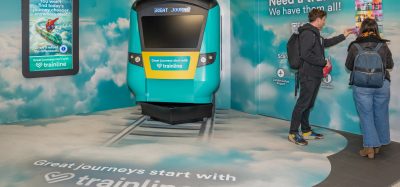Working with partners and customers to achieve environmental targets
- Like
- Digg
- Del
- Tumblr
- VKontakte
- Buffer
- Love This
- Odnoklassniki
- Meneame
- Blogger
- Amazon
- Yahoo Mail
- Gmail
- AOL
- Newsvine
- HackerNews
- Evernote
- MySpace
- Mail.ru
- Viadeo
- Line
- Comments
- Yummly
- SMS
- Viber
- Telegram
- Subscribe
- Skype
- Facebook Messenger
- Kakao
- LiveJournal
- Yammer
- Edgar
- Fintel
- Mix
- Instapaper
- Copy Link
Posted: 30 September 2008 | Carrie Harris, Head of Air Traffic Management Environment, NATS | No comments yet
Carrie Harris is the Head of Air Traffic Management Environment at NATS, the UK’s leading air navigation services provider. NATS provides air traffic control services to aircraft flying in UK airspace and over the eastern part of the North Atlantic…


This year NATS expects to handle some 2.5 million flights carrying approximately 250 million passengers. NATS has acquired something of a reputation for challenging the status quo in air traffic control and earlier this year, we raised the bar again when we became the first ANSP to set specific environmental targets aimed at helping to cut aircraft emissions. As the UK’s leading air navigation services provider, we made a commitment to act responsibly as an organisation; specifically in terms of our ATM environment strategy, we set a target to reduce the ATM CO2 emissions per flight by 10 per cent by 2020, set against a baseline of 2006.
NATS is working very closely with our partners across the industry, both through the Sustainable Aviation coalition and through initiatives. We are exploring with manufacturers and our customer airlines to ensure that we are playing a full role in the industry’s efforts to mitigate aviation’s impact on the environment.
To achieve our ATM emissions target, we are currently scrutinising all our operations including airspace design, network and route management, technology implementation and day-to-day air traffic control operations such as flight climb and descent profiles, aircraft speeds and more direct routes.
In the past year, NATS has developed our strategy to become a progressive player in the aviation environment debate, encouraging a cultural shift within the company to embrace stretching environmental targets and delivering immediate, short-term, environmental improvements, while remaining focused on our long-term plan. Well before 2020, NATS will have consolidated our operation from four centres a year ago, into two state of the art centres at Swanwick and Prestwick to help achieve efficiency and environmental benefits. A key stage of this project was achieved in November 2007 when London Terminal Control controllers moved from West Drayton to Swanwick.
This will help the company to achieve our other environmental target – to make our estate carbon neutral by 2011. These are core elements of the company’s three-year business strategy Vision 2011, focused on achieving 18 key targets, aligned to the company-wide brand values. The focal point for NATS’ environmental activity sits within the Acting Responsibly brand value, which includes three targets covering ATM, its buildings and estate and its social and community impacts:
NATS targets:
- By March 2020, we will have united the industry in reducing ATM CO2 emissions by 10 per cent per flight (against a 2006 baseline). By the end of 2008, clear targets will have been established to deliver this
- Through the commitment of our employees, we will have created a carbon neutral estate by 2011
- By April 2008, we will have introduced a social responsibility fund, administered to support worthy causes and encouraged our employees to support local community projects
When I joined NATS in April 2007, environmental management was limited more or less to mitigating noise in airspace design and through operational practices such as Continuous Descent Approaches (CDAs). Environment was a niche activity and it took some explaining to develop an understanding of what we were trying to achieve.
Eighteen months on and following the launch of Vision 2011, the culture has changed dramatically. Almost all of our 5,000 staff are aware of our environmental goals and want to see the company improve its environmental performance. It is now common to hear discussions among people, for whom environment is not core to their work, discussing the impacts of ATM on noise or climate change and debating the right approach for NATS. Articles on our intranet site as well as high profile communications such as putting large, brightly coloured footprints carrying environmental ‘Hard Facts’ on the floors of our main buildings have sparked debates among staff. It’s all good, healthy debate and signals a remarkable cultural shift in the organisation.
By the end of this year, NATS will have established the 2006 baseline for emissions and continues to research flight profiles which are environmentally beneficial. Establishing the baseline has involved complex data analysis from a range of sources. Care has been taken to ensure that the processes used to calculate the baseline enable NATS to track year on year performance improvements towards its 2020 CO2 efficiency target.
Following this work, NATS is undertaking primary research to evaluate environmentally optimum flight profiles, assess fuel and emissions performance of routes between key UK cities and assess a range of potential improvement measures to determine which will be the most effective in helping achieve the 2020 target. The results of this research will help further develop NATS’ operations, network management and airspace design, as well as offering valuable insight for other ANSPs and the whole ATM sector.
We estimate that the initiatives introduced during 2008 alone have delivered a reduction in CO2 emissions in excess of 70,000 tonnes – the first time we have been able to measure our performance in this way. We are also working hard with staff to ensure everyone is aware of and understands the opportunities available to them to deliver performance improvements today. We are actively seeking opportunities to develop and deliver further improvements in future.
In line with our target, we are now developing a plan to deliver the efficiency gains necessary to meet our 10 per cent reduction in CO2 per flight. The plan covers all areas of NATS’ ATM influence, including airspace design, operations, staff training and awareness, ATM technology and cross industry influence and collaboration – working hand in hand with our customers.
We took a conscious decision to be the standard bearers for the environmental agenda among ANSPs and to encourage positive action among others at numerous UK and international industry conferences and meetings. We played a leading role in establishing the environmental work stream in the policy work at the ATC industry body CANSO (the Civil Air Navigation Services Organisation) and continue to play a prominent role in the working group.
NATS’ Chief Executive, Paul Barron, is the environment champion on the CANSO Executive Committee and has been instrumental in shaping CANSO’s Imagine 2010 strategy, embedding environment as one of its top three priorities alongside safety and business transformation. This year, having helped shape the group’s Workplan for the next three years, NATS has been instrumental in supporting CANSO’s efforts to develop a global benchmark for efficiency in the ATM system, as well as playing a key role in CANSO’s work to establish a global emissions reduction target for the ANSP sector as part of the international agenda led by ICAO’s Group on International Aviation Climate Change (GIACC).
We have been very active across the industry, both in the UK and internationally and we intend to increase that activity in future. We will be continuing our work in the UK Sustainable Aviation group, focusing on noise and climate-related topics as well as playing an active role in initiatives, looking at how fuel efficiency can be optimised by adjusting route structures. We are also extending our relationship with a number of professional organisations which are assisting us in our ground-breaking research on the ATM environment.
Progress this year has been excellent, but we are not complacent. We are in no doubt that the challenges ahead are immense, not least in addressing the ongoing trade-offs between performance efficiency, managing aircraft noise and minimising emission and working with Government and regulatory authorities to help inform their policy considerations in these often sensitive areas.
To achieve our environmental targets as well as meet our other business imperatives, NATS must find a sustainable balance between environmental mitigation, demand for airspace capacity and acceptable operator costs. We are determined to harness the enthusiasm that has enveloped the organisation and to use it to inspire others to join them in rising to the industry’s environmental challenges and reducing its environmental impacts.


















